Charles Sturt University Hacking Assignment: Ethical Theory Analysis
VerifiedAdded on 2021/06/16
|8
|2303
|56
Homework Assignment
AI Summary
This assignment, submitted by a student from the School of Computing and Maths at Charles Sturt University, examines the ethical dimensions of hacking. The student analyzes hacking incidents through the lenses of classical ethical theories, including utilitarianism, deontology, virtue theory, and contract theory. The assignment explores various aspects of hacking, such as data diddling, denial-of-service attacks, social engineering, and identity theft, and discusses the responsibilities of companies in safeguarding sensitive information. The student references articles and studies to support arguments about the impact of hacking, the importance of security awareness, and the legal consequences of data breaches. The conclusion emphasizes the need for effective regulation and legislation to manage computer crime and misuse, and the necessity of educating corporations and the public about hacking techniques and their consequences.
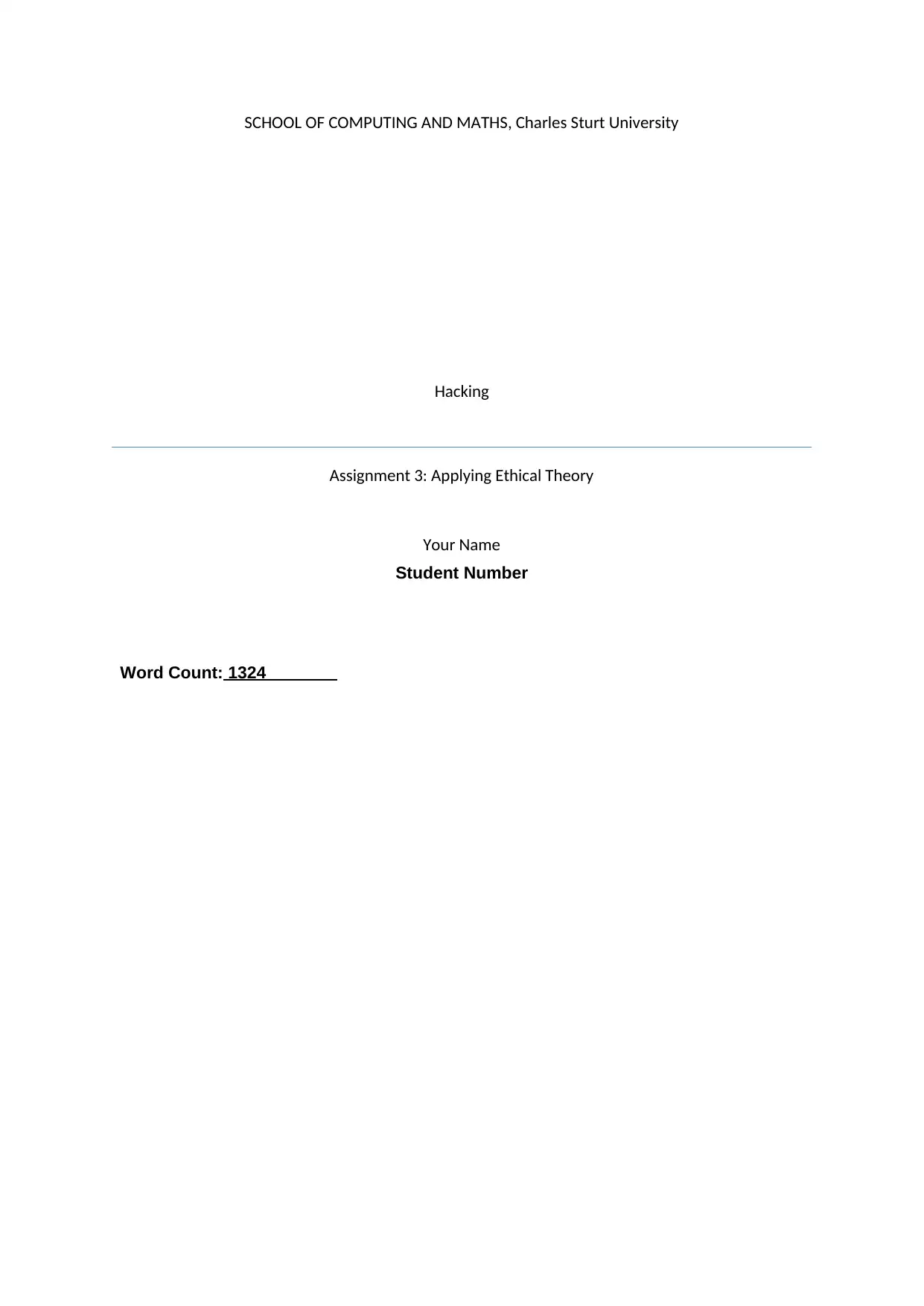
SCHOOL OF COMPUTING AND MATHS, Charles Sturt University
Hacking
Assignment 3: Applying Ethical Theory
Your Name
Student Number
Word Count: 1324
Hacking
Assignment 3: Applying Ethical Theory
Your Name
Student Number
Word Count: 1324
Paraphrase This Document
Need a fresh take? Get an instant paraphrase of this document with our AI Paraphraser
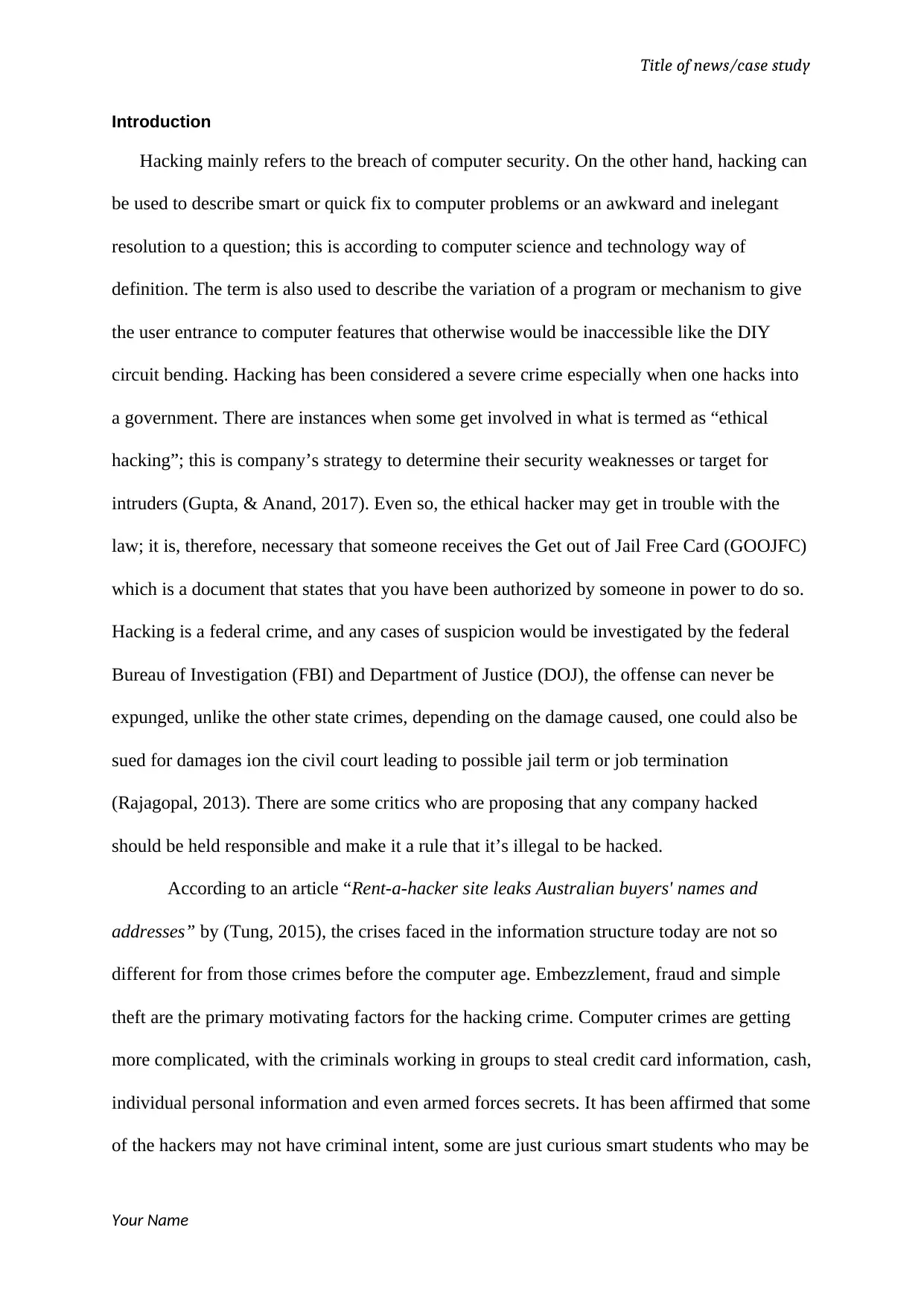
Title of news/case study
Introduction
Hacking mainly refers to the breach of computer security. On the other hand, hacking can
be used to describe smart or quick fix to computer problems or an awkward and inelegant
resolution to a question; this is according to computer science and technology way of
definition. The term is also used to describe the variation of a program or mechanism to give
the user entrance to computer features that otherwise would be inaccessible like the DIY
circuit bending. Hacking has been considered a severe crime especially when one hacks into
a government. There are instances when some get involved in what is termed as “ethical
hacking”; this is company’s strategy to determine their security weaknesses or target for
intruders (Gupta, & Anand, 2017). Even so, the ethical hacker may get in trouble with the
law; it is, therefore, necessary that someone receives the Get out of Jail Free Card (GOOJFC)
which is a document that states that you have been authorized by someone in power to do so.
Hacking is a federal crime, and any cases of suspicion would be investigated by the federal
Bureau of Investigation (FBI) and Department of Justice (DOJ), the offense can never be
expunged, unlike the other state crimes, depending on the damage caused, one could also be
sued for damages ion the civil court leading to possible jail term or job termination
(Rajagopal, 2013). There are some critics who are proposing that any company hacked
should be held responsible and make it a rule that it’s illegal to be hacked.
According to an article “Rent-a-hacker site leaks Australian buyers' names and
addresses” by (Tung, 2015), the crises faced in the information structure today are not so
different for from those crimes before the computer age. Embezzlement, fraud and simple
theft are the primary motivating factors for the hacking crime. Computer crimes are getting
more complicated, with the criminals working in groups to steal credit card information, cash,
individual personal information and even armed forces secrets. It has been affirmed that some
of the hackers may not have criminal intent, some are just curious smart students who may be
Your Name
Introduction
Hacking mainly refers to the breach of computer security. On the other hand, hacking can
be used to describe smart or quick fix to computer problems or an awkward and inelegant
resolution to a question; this is according to computer science and technology way of
definition. The term is also used to describe the variation of a program or mechanism to give
the user entrance to computer features that otherwise would be inaccessible like the DIY
circuit bending. Hacking has been considered a severe crime especially when one hacks into
a government. There are instances when some get involved in what is termed as “ethical
hacking”; this is company’s strategy to determine their security weaknesses or target for
intruders (Gupta, & Anand, 2017). Even so, the ethical hacker may get in trouble with the
law; it is, therefore, necessary that someone receives the Get out of Jail Free Card (GOOJFC)
which is a document that states that you have been authorized by someone in power to do so.
Hacking is a federal crime, and any cases of suspicion would be investigated by the federal
Bureau of Investigation (FBI) and Department of Justice (DOJ), the offense can never be
expunged, unlike the other state crimes, depending on the damage caused, one could also be
sued for damages ion the civil court leading to possible jail term or job termination
(Rajagopal, 2013). There are some critics who are proposing that any company hacked
should be held responsible and make it a rule that it’s illegal to be hacked.
According to an article “Rent-a-hacker site leaks Australian buyers' names and
addresses” by (Tung, 2015), the crises faced in the information structure today are not so
different for from those crimes before the computer age. Embezzlement, fraud and simple
theft are the primary motivating factors for the hacking crime. Computer crimes are getting
more complicated, with the criminals working in groups to steal credit card information, cash,
individual personal information and even armed forces secrets. It has been affirmed that some
of the hackers may not have criminal intent, some are just curious smart students who may be
Your Name
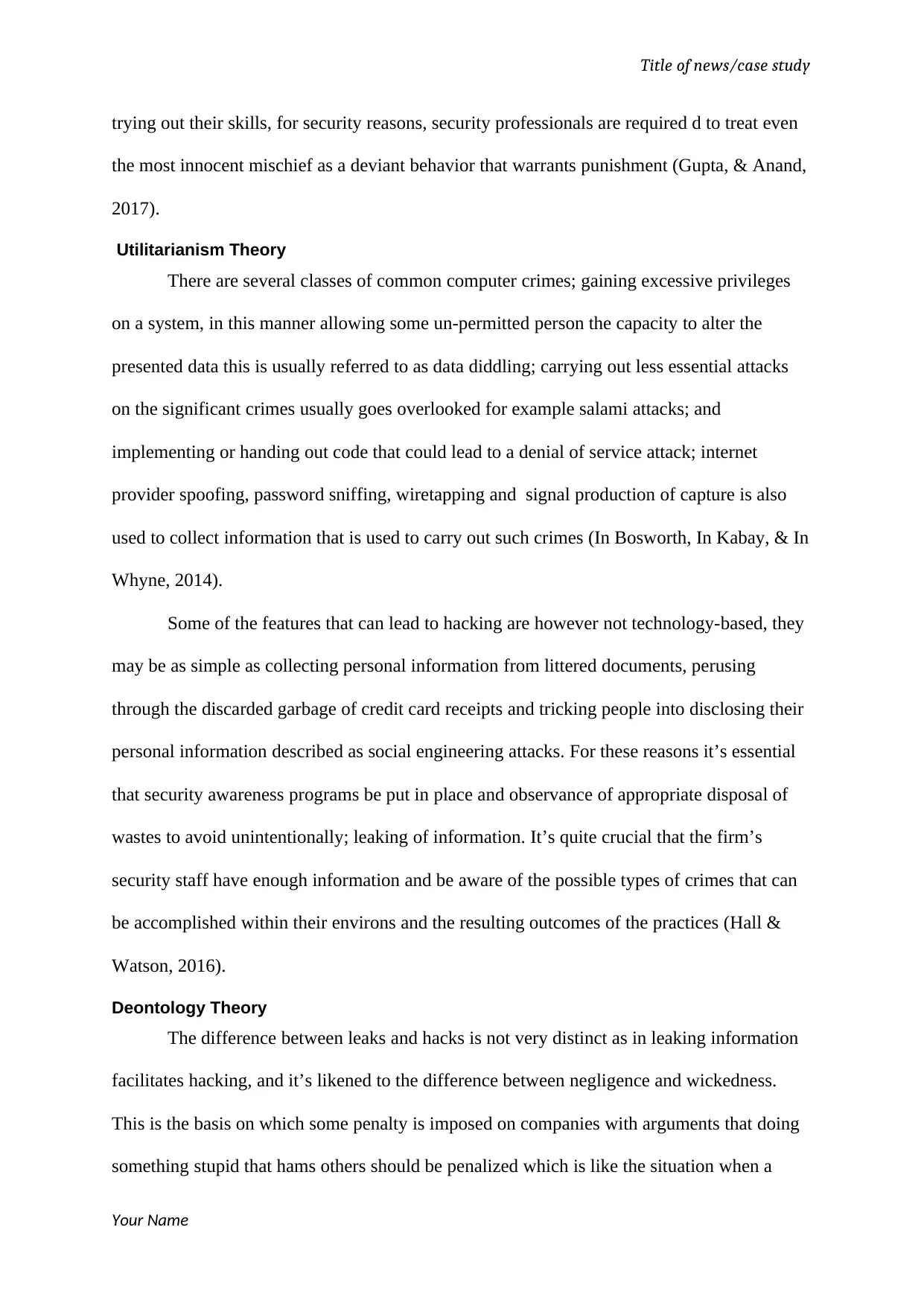
Title of news/case study
trying out their skills, for security reasons, security professionals are required d to treat even
the most innocent mischief as a deviant behavior that warrants punishment (Gupta, & Anand,
2017).
Utilitarianism Theory
There are several classes of common computer crimes; gaining excessive privileges
on a system, in this manner allowing some un-permitted person the capacity to alter the
presented data this is usually referred to as data diddling; carrying out less essential attacks
on the significant crimes usually goes overlooked for example salami attacks; and
implementing or handing out code that could lead to a denial of service attack; internet
provider spoofing, password sniffing, wiretapping and signal production of capture is also
used to collect information that is used to carry out such crimes (In Bosworth, In Kabay, & In
Whyne, 2014).
Some of the features that can lead to hacking are however not technology-based, they
may be as simple as collecting personal information from littered documents, perusing
through the discarded garbage of credit card receipts and tricking people into disclosing their
personal information described as social engineering attacks. For these reasons it’s essential
that security awareness programs be put in place and observance of appropriate disposal of
wastes to avoid unintentionally; leaking of information. It’s quite crucial that the firm’s
security staff have enough information and be aware of the possible types of crimes that can
be accomplished within their environs and the resulting outcomes of the practices (Hall &
Watson, 2016).
Deontology Theory
The difference between leaks and hacks is not very distinct as in leaking information
facilitates hacking, and it’s likened to the difference between negligence and wickedness.
This is the basis on which some penalty is imposed on companies with arguments that doing
something stupid that hams others should be penalized which is like the situation when a
Your Name
trying out their skills, for security reasons, security professionals are required d to treat even
the most innocent mischief as a deviant behavior that warrants punishment (Gupta, & Anand,
2017).
Utilitarianism Theory
There are several classes of common computer crimes; gaining excessive privileges
on a system, in this manner allowing some un-permitted person the capacity to alter the
presented data this is usually referred to as data diddling; carrying out less essential attacks
on the significant crimes usually goes overlooked for example salami attacks; and
implementing or handing out code that could lead to a denial of service attack; internet
provider spoofing, password sniffing, wiretapping and signal production of capture is also
used to collect information that is used to carry out such crimes (In Bosworth, In Kabay, & In
Whyne, 2014).
Some of the features that can lead to hacking are however not technology-based, they
may be as simple as collecting personal information from littered documents, perusing
through the discarded garbage of credit card receipts and tricking people into disclosing their
personal information described as social engineering attacks. For these reasons it’s essential
that security awareness programs be put in place and observance of appropriate disposal of
wastes to avoid unintentionally; leaking of information. It’s quite crucial that the firm’s
security staff have enough information and be aware of the possible types of crimes that can
be accomplished within their environs and the resulting outcomes of the practices (Hall &
Watson, 2016).
Deontology Theory
The difference between leaks and hacks is not very distinct as in leaking information
facilitates hacking, and it’s likened to the difference between negligence and wickedness.
This is the basis on which some penalty is imposed on companies with arguments that doing
something stupid that hams others should be penalized which is like the situation when a
Your Name
⊘ This is a preview!⊘
Do you want full access?
Subscribe today to unlock all pages.

Trusted by 1+ million students worldwide
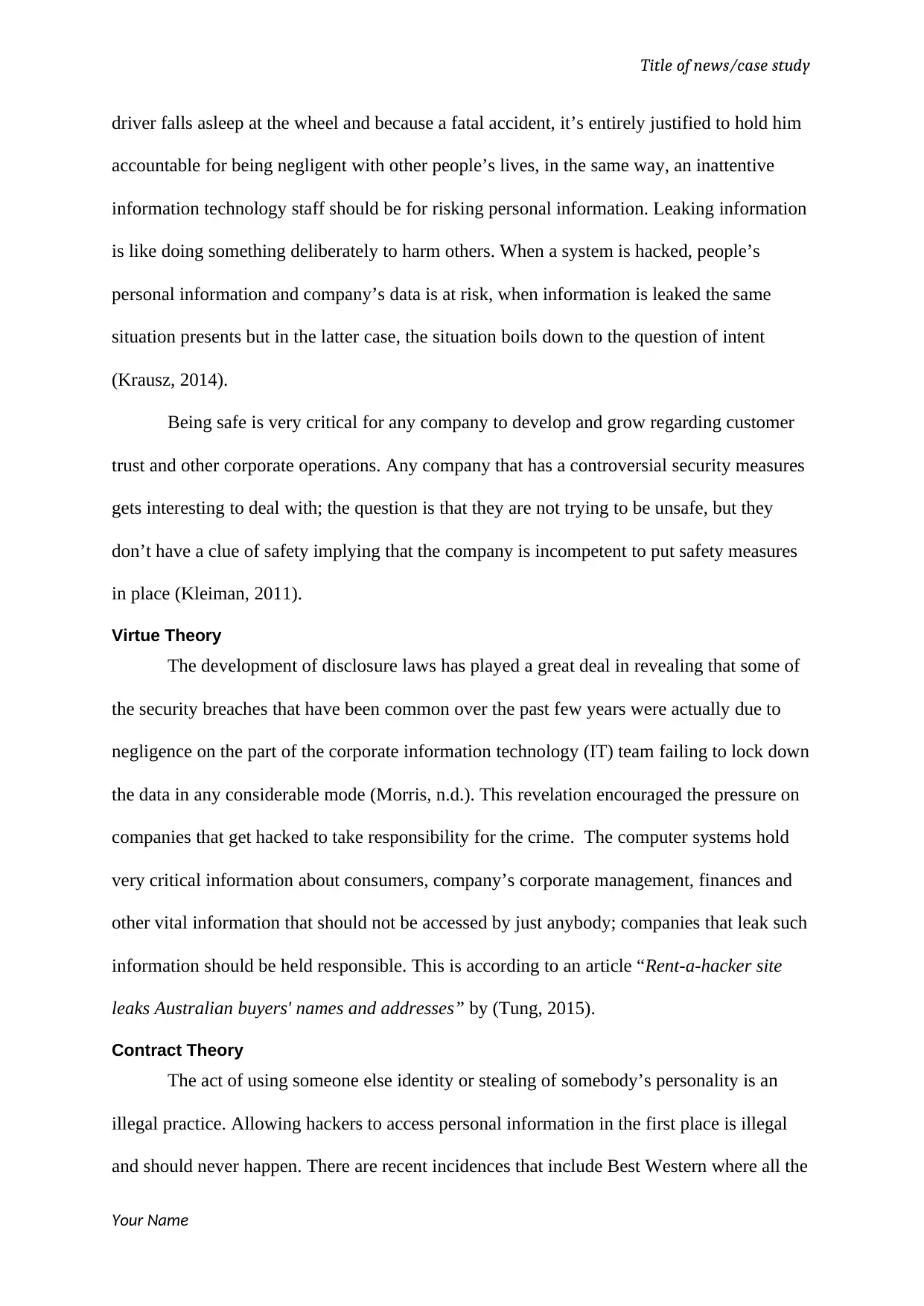
Title of news/case study
driver falls asleep at the wheel and because a fatal accident, it’s entirely justified to hold him
accountable for being negligent with other people’s lives, in the same way, an inattentive
information technology staff should be for risking personal information. Leaking information
is like doing something deliberately to harm others. When a system is hacked, people’s
personal information and company’s data is at risk, when information is leaked the same
situation presents but in the latter case, the situation boils down to the question of intent
(Krausz, 2014).
Being safe is very critical for any company to develop and grow regarding customer
trust and other corporate operations. Any company that has a controversial security measures
gets interesting to deal with; the question is that they are not trying to be unsafe, but they
don’t have a clue of safety implying that the company is incompetent to put safety measures
in place (Kleiman, 2011).
Virtue Theory
The development of disclosure laws has played a great deal in revealing that some of
the security breaches that have been common over the past few years were actually due to
negligence on the part of the corporate information technology (IT) team failing to lock down
the data in any considerable mode (Morris, n.d.). This revelation encouraged the pressure on
companies that get hacked to take responsibility for the crime. The computer systems hold
very critical information about consumers, company’s corporate management, finances and
other vital information that should not be accessed by just anybody; companies that leak such
information should be held responsible. This is according to an article “Rent-a-hacker site
leaks Australian buyers' names and addresses” by (Tung, 2015).
Contract Theory
The act of using someone else identity or stealing of somebody’s personality is an
illegal practice. Allowing hackers to access personal information in the first place is illegal
and should never happen. There are recent incidences that include Best Western where all the
Your Name
driver falls asleep at the wheel and because a fatal accident, it’s entirely justified to hold him
accountable for being negligent with other people’s lives, in the same way, an inattentive
information technology staff should be for risking personal information. Leaking information
is like doing something deliberately to harm others. When a system is hacked, people’s
personal information and company’s data is at risk, when information is leaked the same
situation presents but in the latter case, the situation boils down to the question of intent
(Krausz, 2014).
Being safe is very critical for any company to develop and grow regarding customer
trust and other corporate operations. Any company that has a controversial security measures
gets interesting to deal with; the question is that they are not trying to be unsafe, but they
don’t have a clue of safety implying that the company is incompetent to put safety measures
in place (Kleiman, 2011).
Virtue Theory
The development of disclosure laws has played a great deal in revealing that some of
the security breaches that have been common over the past few years were actually due to
negligence on the part of the corporate information technology (IT) team failing to lock down
the data in any considerable mode (Morris, n.d.). This revelation encouraged the pressure on
companies that get hacked to take responsibility for the crime. The computer systems hold
very critical information about consumers, company’s corporate management, finances and
other vital information that should not be accessed by just anybody; companies that leak such
information should be held responsible. This is according to an article “Rent-a-hacker site
leaks Australian buyers' names and addresses” by (Tung, 2015).
Contract Theory
The act of using someone else identity or stealing of somebody’s personality is an
illegal practice. Allowing hackers to access personal information in the first place is illegal
and should never happen. There are recent incidences that include Best Western where all the
Your Name
Paraphrase This Document
Need a fresh take? Get an instant paraphrase of this document with our AI Paraphraser
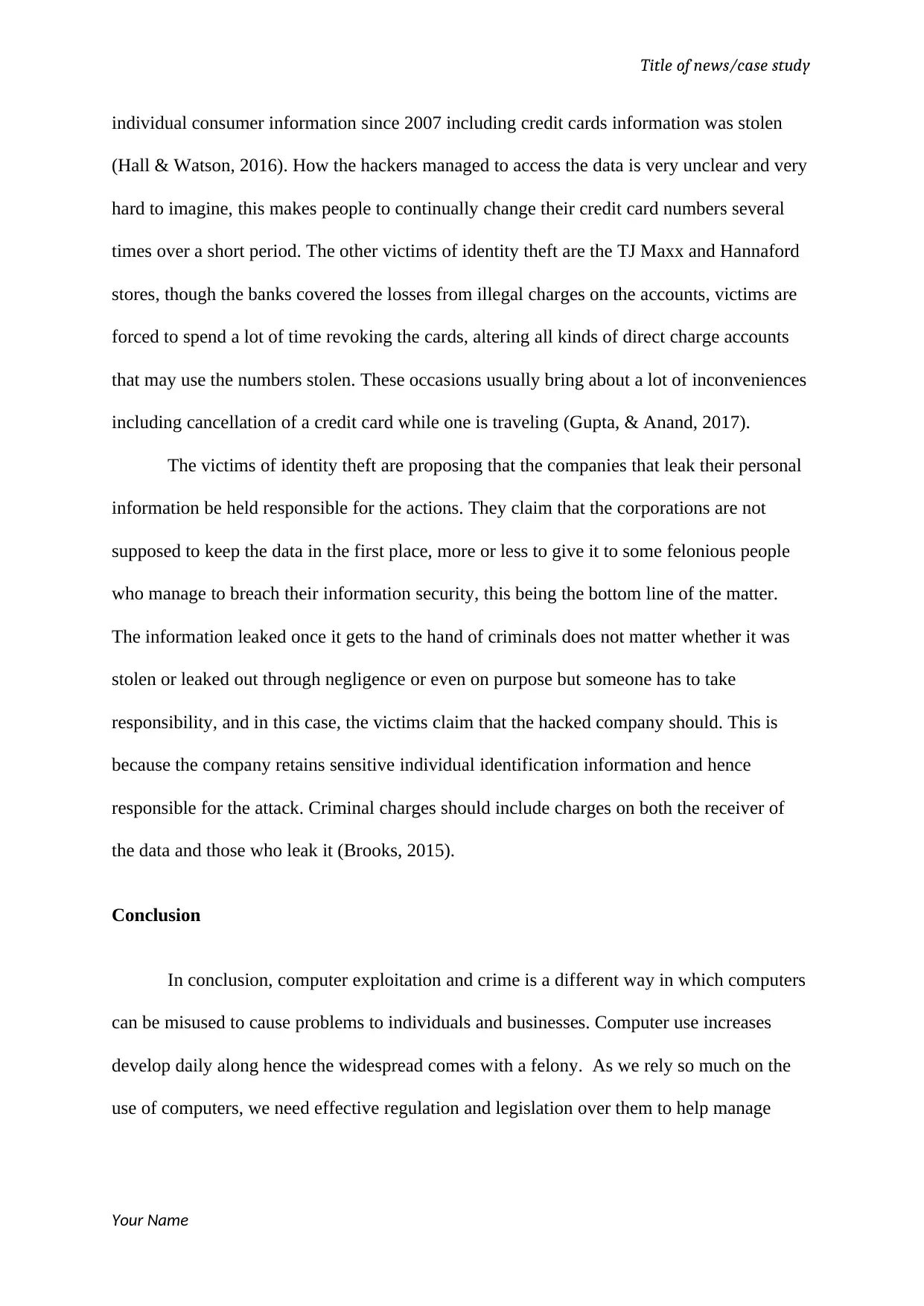
Title of news/case study
individual consumer information since 2007 including credit cards information was stolen
(Hall & Watson, 2016). How the hackers managed to access the data is very unclear and very
hard to imagine, this makes people to continually change their credit card numbers several
times over a short period. The other victims of identity theft are the TJ Maxx and Hannaford
stores, though the banks covered the losses from illegal charges on the accounts, victims are
forced to spend a lot of time revoking the cards, altering all kinds of direct charge accounts
that may use the numbers stolen. These occasions usually bring about a lot of inconveniences
including cancellation of a credit card while one is traveling (Gupta, & Anand, 2017).
The victims of identity theft are proposing that the companies that leak their personal
information be held responsible for the actions. They claim that the corporations are not
supposed to keep the data in the first place, more or less to give it to some felonious people
who manage to breach their information security, this being the bottom line of the matter.
The information leaked once it gets to the hand of criminals does not matter whether it was
stolen or leaked out through negligence or even on purpose but someone has to take
responsibility, and in this case, the victims claim that the hacked company should. This is
because the company retains sensitive individual identification information and hence
responsible for the attack. Criminal charges should include charges on both the receiver of
the data and those who leak it (Brooks, 2015).
Conclusion
In conclusion, computer exploitation and crime is a different way in which computers
can be misused to cause problems to individuals and businesses. Computer use increases
develop daily along hence the widespread comes with a felony. As we rely so much on the
use of computers, we need effective regulation and legislation over them to help manage
Your Name
individual consumer information since 2007 including credit cards information was stolen
(Hall & Watson, 2016). How the hackers managed to access the data is very unclear and very
hard to imagine, this makes people to continually change their credit card numbers several
times over a short period. The other victims of identity theft are the TJ Maxx and Hannaford
stores, though the banks covered the losses from illegal charges on the accounts, victims are
forced to spend a lot of time revoking the cards, altering all kinds of direct charge accounts
that may use the numbers stolen. These occasions usually bring about a lot of inconveniences
including cancellation of a credit card while one is traveling (Gupta, & Anand, 2017).
The victims of identity theft are proposing that the companies that leak their personal
information be held responsible for the actions. They claim that the corporations are not
supposed to keep the data in the first place, more or less to give it to some felonious people
who manage to breach their information security, this being the bottom line of the matter.
The information leaked once it gets to the hand of criminals does not matter whether it was
stolen or leaked out through negligence or even on purpose but someone has to take
responsibility, and in this case, the victims claim that the hacked company should. This is
because the company retains sensitive individual identification information and hence
responsible for the attack. Criminal charges should include charges on both the receiver of
the data and those who leak it (Brooks, 2015).
Conclusion
In conclusion, computer exploitation and crime is a different way in which computers
can be misused to cause problems to individuals and businesses. Computer use increases
develop daily along hence the widespread comes with a felony. As we rely so much on the
use of computers, we need effective regulation and legislation over them to help manage
Your Name
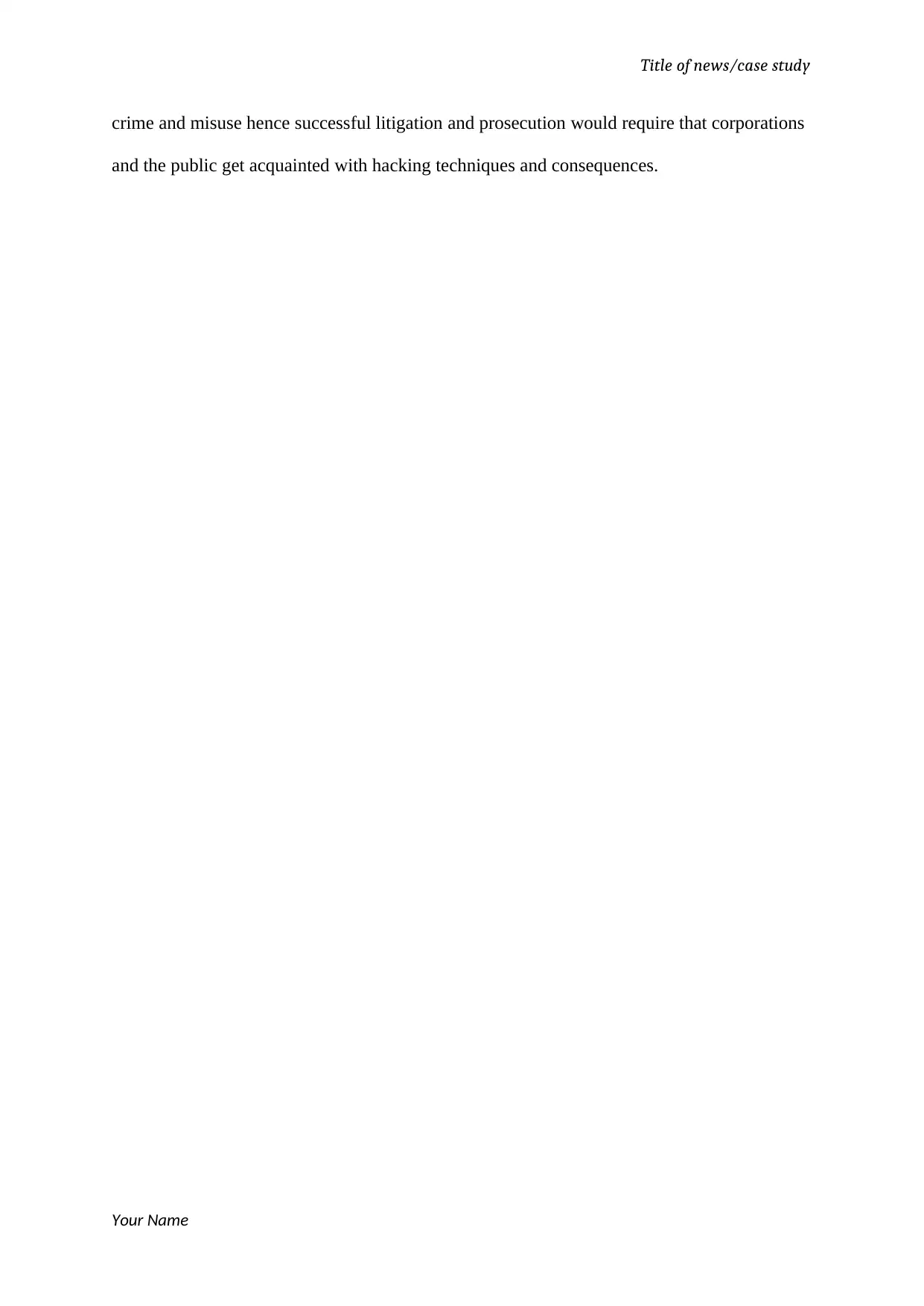
Title of news/case study
crime and misuse hence successful litigation and prosecution would require that corporations
and the public get acquainted with hacking techniques and consequences.
Your Name
crime and misuse hence successful litigation and prosecution would require that corporations
and the public get acquainted with hacking techniques and consequences.
Your Name
⊘ This is a preview!⊘
Do you want full access?
Subscribe today to unlock all pages.

Trusted by 1+ million students worldwide
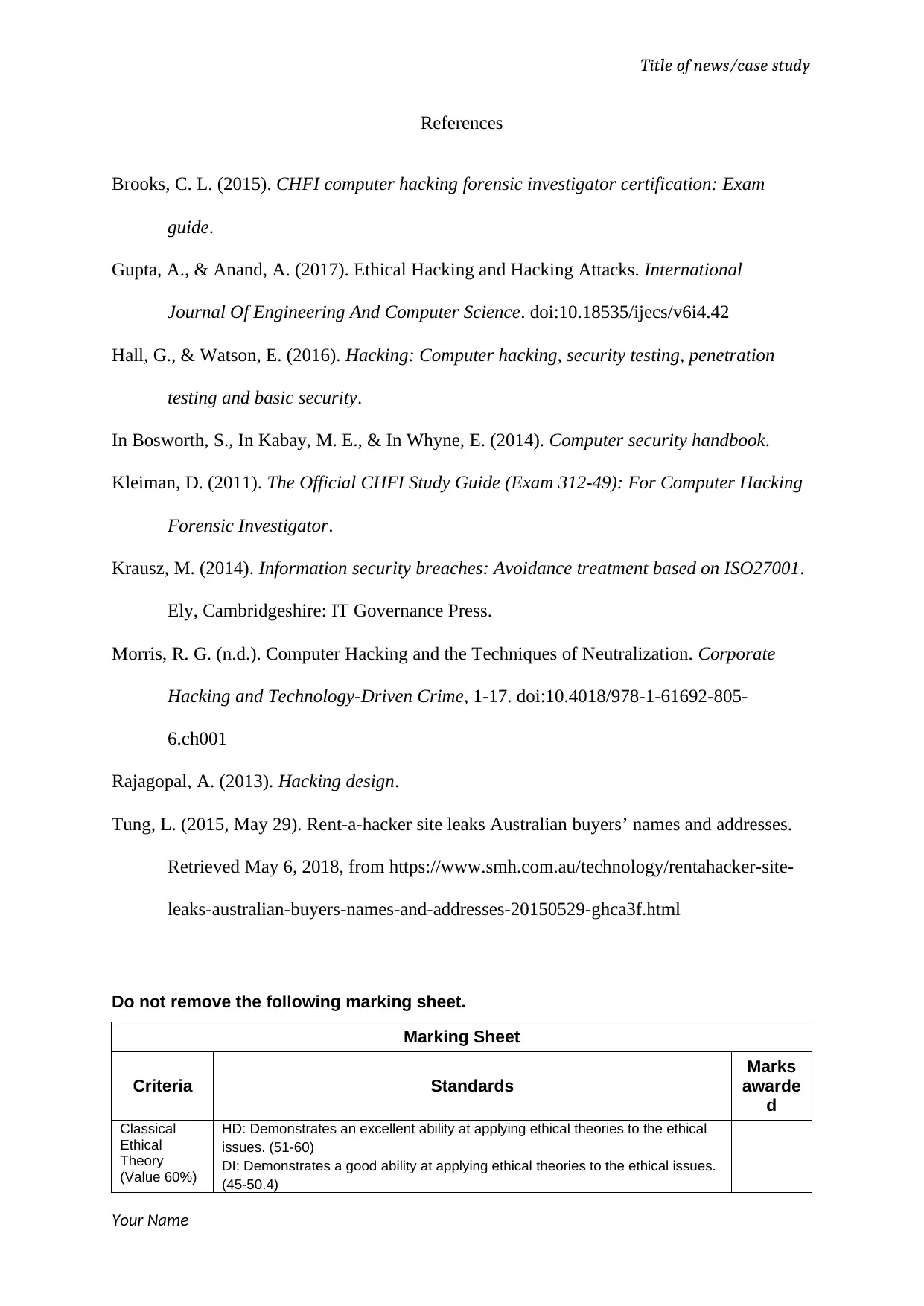
Title of news/case study
References
Brooks, C. L. (2015). CHFI computer hacking forensic investigator certification: Exam
guide.
Gupta, A., & Anand, A. (2017). Ethical Hacking and Hacking Attacks. International
Journal Of Engineering And Computer Science. doi:10.18535/ijecs/v6i4.42
Hall, G., & Watson, E. (2016). Hacking: Computer hacking, security testing, penetration
testing and basic security.
In Bosworth, S., In Kabay, M. E., & In Whyne, E. (2014). Computer security handbook.
Kleiman, D. (2011). The Official CHFI Study Guide (Exam 312-49): For Computer Hacking
Forensic Investigator.
Krausz, M. (2014). Information security breaches: Avoidance treatment based on ISO27001.
Ely, Cambridgeshire: IT Governance Press.
Morris, R. G. (n.d.). Computer Hacking and the Techniques of Neutralization. Corporate
Hacking and Technology-Driven Crime, 1-17. doi:10.4018/978-1-61692-805-
6.ch001
Rajagopal, A. (2013). Hacking design.
Tung, L. (2015, May 29). Rent-a-hacker site leaks Australian buyers’ names and addresses.
Retrieved May 6, 2018, from https://www.smh.com.au/technology/rentahacker-site-
leaks-australian-buyers-names-and-addresses-20150529-ghca3f.html
Do not remove the following marking sheet.
Marking Sheet
Criteria Standards
Marks
awarde
d
Classical
Ethical
Theory
(Value 60%)
HD: Demonstrates an excellent ability at applying ethical theories to the ethical
issues. (51-60)
DI: Demonstrates a good ability at applying ethical theories to the ethical issues.
(45-50.4)
Your Name
References
Brooks, C. L. (2015). CHFI computer hacking forensic investigator certification: Exam
guide.
Gupta, A., & Anand, A. (2017). Ethical Hacking and Hacking Attacks. International
Journal Of Engineering And Computer Science. doi:10.18535/ijecs/v6i4.42
Hall, G., & Watson, E. (2016). Hacking: Computer hacking, security testing, penetration
testing and basic security.
In Bosworth, S., In Kabay, M. E., & In Whyne, E. (2014). Computer security handbook.
Kleiman, D. (2011). The Official CHFI Study Guide (Exam 312-49): For Computer Hacking
Forensic Investigator.
Krausz, M. (2014). Information security breaches: Avoidance treatment based on ISO27001.
Ely, Cambridgeshire: IT Governance Press.
Morris, R. G. (n.d.). Computer Hacking and the Techniques of Neutralization. Corporate
Hacking and Technology-Driven Crime, 1-17. doi:10.4018/978-1-61692-805-
6.ch001
Rajagopal, A. (2013). Hacking design.
Tung, L. (2015, May 29). Rent-a-hacker site leaks Australian buyers’ names and addresses.
Retrieved May 6, 2018, from https://www.smh.com.au/technology/rentahacker-site-
leaks-australian-buyers-names-and-addresses-20150529-ghca3f.html
Do not remove the following marking sheet.
Marking Sheet
Criteria Standards
Marks
awarde
d
Classical
Ethical
Theory
(Value 60%)
HD: Demonstrates an excellent ability at applying ethical theories to the ethical
issues. (51-60)
DI: Demonstrates a good ability at applying ethical theories to the ethical issues.
(45-50.4)
Your Name
Paraphrase This Document
Need a fresh take? Get an instant paraphrase of this document with our AI Paraphraser
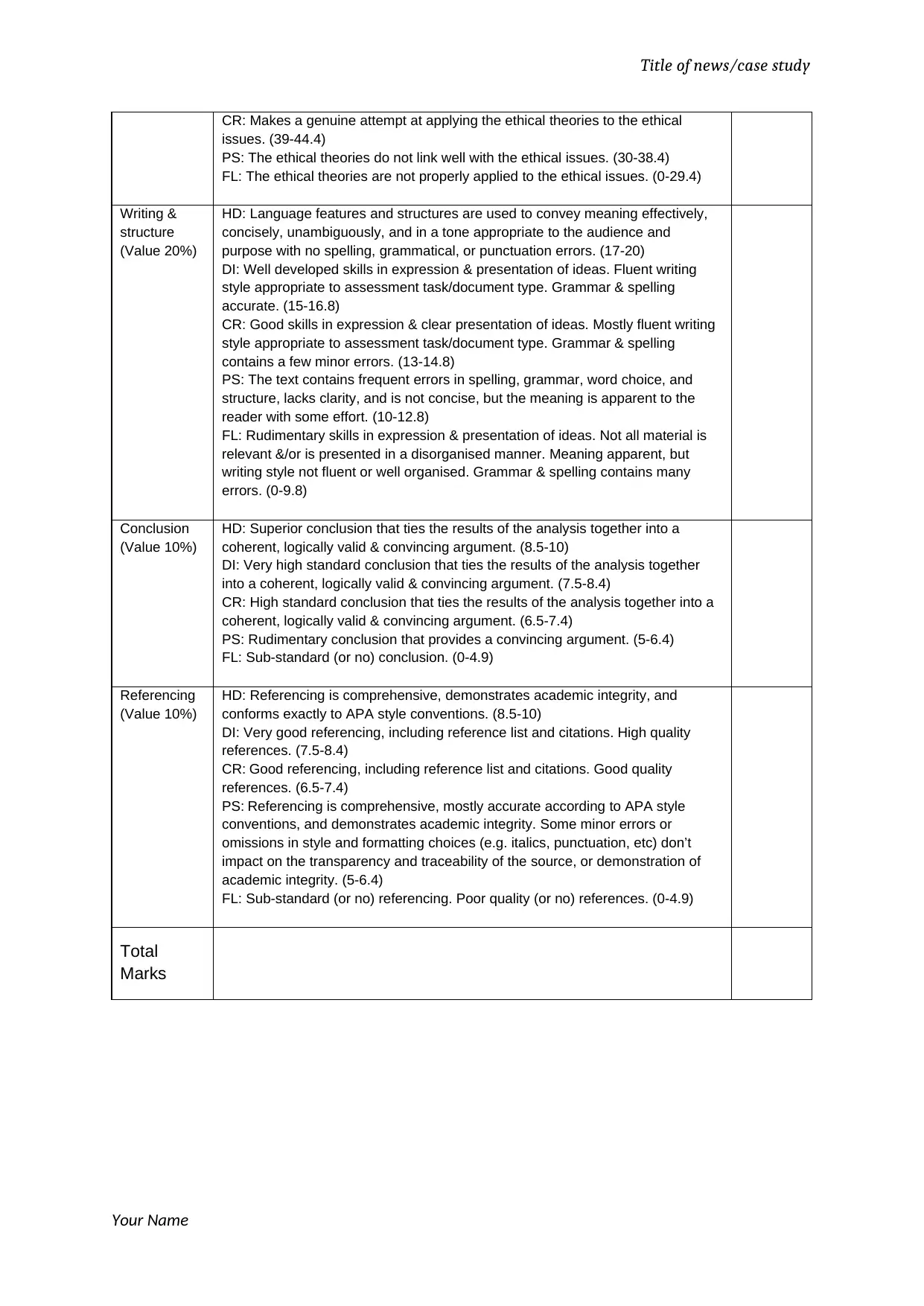
Title of news/case study
CR: Makes a genuine attempt at applying the ethical theories to the ethical
issues. (39-44.4)
PS: The ethical theories do not link well with the ethical issues. (30-38.4)
FL: The ethical theories are not properly applied to the ethical issues. (0-29.4)
Writing &
structure
(Value 20%)
HD: Language features and structures are used to convey meaning effectively,
concisely, unambiguously, and in a tone appropriate to the audience and
purpose with no spelling, grammatical, or punctuation errors. (17-20)
DI: Well developed skills in expression & presentation of ideas. Fluent writing
style appropriate to assessment task/document type. Grammar & spelling
accurate. (15-16.8)
CR: Good skills in expression & clear presentation of ideas. Mostly fluent writing
style appropriate to assessment task/document type. Grammar & spelling
contains a few minor errors. (13-14.8)
PS: The text contains frequent errors in spelling, grammar, word choice, and
structure, lacks clarity, and is not concise, but the meaning is apparent to the
reader with some effort. (10-12.8)
FL: Rudimentary skills in expression & presentation of ideas. Not all material is
relevant &/or is presented in a disorganised manner. Meaning apparent, but
writing style not fluent or well organised. Grammar & spelling contains many
errors. (0-9.8)
Conclusion
(Value 10%)
HD: Superior conclusion that ties the results of the analysis together into a
coherent, logically valid & convincing argument. (8.5-10)
DI: Very high standard conclusion that ties the results of the analysis together
into a coherent, logically valid & convincing argument. (7.5-8.4)
CR: High standard conclusion that ties the results of the analysis together into a
coherent, logically valid & convincing argument. (6.5-7.4)
PS: Rudimentary conclusion that provides a convincing argument. (5-6.4)
FL: Sub-standard (or no) conclusion. (0-4.9)
Referencing
(Value 10%)
HD: Referencing is comprehensive, demonstrates academic integrity, and
conforms exactly to APA style conventions. (8.5-10)
DI: Very good referencing, including reference list and citations. High quality
references. (7.5-8.4)
CR: Good referencing, including reference list and citations. Good quality
references. (6.5-7.4)
PS: Referencing is comprehensive, mostly accurate according to APA style
conventions, and demonstrates academic integrity. Some minor errors or
omissions in style and formatting choices (e.g. italics, punctuation, etc) don’t
impact on the transparency and traceability of the source, or demonstration of
academic integrity. (5-6.4)
FL: Sub-standard (or no) referencing. Poor quality (or no) references. (0-4.9)
Total
Marks
Your Name
CR: Makes a genuine attempt at applying the ethical theories to the ethical
issues. (39-44.4)
PS: The ethical theories do not link well with the ethical issues. (30-38.4)
FL: The ethical theories are not properly applied to the ethical issues. (0-29.4)
Writing &
structure
(Value 20%)
HD: Language features and structures are used to convey meaning effectively,
concisely, unambiguously, and in a tone appropriate to the audience and
purpose with no spelling, grammatical, or punctuation errors. (17-20)
DI: Well developed skills in expression & presentation of ideas. Fluent writing
style appropriate to assessment task/document type. Grammar & spelling
accurate. (15-16.8)
CR: Good skills in expression & clear presentation of ideas. Mostly fluent writing
style appropriate to assessment task/document type. Grammar & spelling
contains a few minor errors. (13-14.8)
PS: The text contains frequent errors in spelling, grammar, word choice, and
structure, lacks clarity, and is not concise, but the meaning is apparent to the
reader with some effort. (10-12.8)
FL: Rudimentary skills in expression & presentation of ideas. Not all material is
relevant &/or is presented in a disorganised manner. Meaning apparent, but
writing style not fluent or well organised. Grammar & spelling contains many
errors. (0-9.8)
Conclusion
(Value 10%)
HD: Superior conclusion that ties the results of the analysis together into a
coherent, logically valid & convincing argument. (8.5-10)
DI: Very high standard conclusion that ties the results of the analysis together
into a coherent, logically valid & convincing argument. (7.5-8.4)
CR: High standard conclusion that ties the results of the analysis together into a
coherent, logically valid & convincing argument. (6.5-7.4)
PS: Rudimentary conclusion that provides a convincing argument. (5-6.4)
FL: Sub-standard (or no) conclusion. (0-4.9)
Referencing
(Value 10%)
HD: Referencing is comprehensive, demonstrates academic integrity, and
conforms exactly to APA style conventions. (8.5-10)
DI: Very good referencing, including reference list and citations. High quality
references. (7.5-8.4)
CR: Good referencing, including reference list and citations. Good quality
references. (6.5-7.4)
PS: Referencing is comprehensive, mostly accurate according to APA style
conventions, and demonstrates academic integrity. Some minor errors or
omissions in style and formatting choices (e.g. italics, punctuation, etc) don’t
impact on the transparency and traceability of the source, or demonstration of
academic integrity. (5-6.4)
FL: Sub-standard (or no) referencing. Poor quality (or no) references. (0-4.9)
Total
Marks
Your Name
1 out of 8
Related Documents
Your All-in-One AI-Powered Toolkit for Academic Success.
+13062052269
info@desklib.com
Available 24*7 on WhatsApp / Email
![[object Object]](/_next/static/media/star-bottom.7253800d.svg)
Unlock your academic potential
Copyright © 2020–2025 A2Z Services. All Rights Reserved. Developed and managed by ZUCOL.





